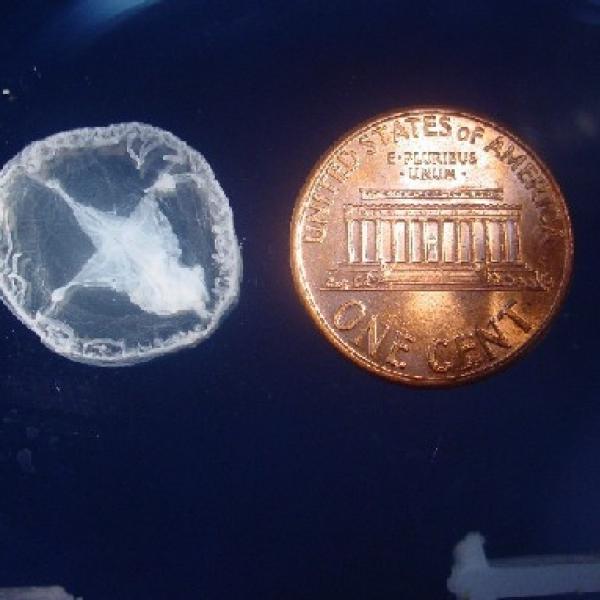
Yes, they are real! Craspedacusta sowerbyi, or peach blossom fish or simply freshwater jellyfish, are indigenous to the Yangtze River in China and were first observed in Vermont in 1999. In the native range, C. sowerbyi will inhabit shallow pools which exposes the species to fluctuating water levels, temperatures, and phytoplankton populations. When studied, the species preferred still, or slow moving, mesotrophic waterbodies between 54-92⁰F. Since 1999, freshwater jellyfish have been spotted in several Vermont lakes, ponds, and river across the state, so how were they introduced and are they a threat?
Means of Introduction
Initially, C. sowerbyi was likely transported with ornamental plants from China such as water hyacinth. In the United States, the resting bodies of C. sowerbyi are likely transported accidentally with stocked fish and aquatic plants, or by waterfowl. The transportation by waterfowl likely explains why we see this species in some remote ponds throughout Vermont.
Identification
C. sowerbyi is a hydrozoan and is most easily identified when it takes the form of a small, bell-shaped jellyfish, known as a hydromedusa. The hydromedusa is approximately an inch in diameter (5-25mm) and is translucent, with a whitish or greenish coloration They have four long tentacles that assist with swimming and 50 to 500 shorter tentacles used for feeding. Swarms, or groups of freshwater jellyfish, may appear together periodically or appear unpredictably in a waterbody depending on the life stage and environmental conditions. It is likely that the chance sightings that have occurred in Vermont within river and waterbodies, are due to these population shifts during extreme heat waves.
Impact of Introduction and Invasive Species Status?
The population impacts of C. sowerbyi is unclear. Short-term lab studies indicated that the hydromedusa consume zooplankton prey, such as daphnia and copepods ranging in size from 0.2 to 2.0 mm, but neither invertebrate planktonic predators nor fish in turn, eat the hydromedusa. Although, crayfish would readily eat the medusa during the feeding trials in the lab. Not enough information is known about their place, or displacement of other native competitors, in the food chain. Dodson and Cooper (1983) noted that the hydromedusa probably does not reduce the zooplankton populations enough to compete with fish, shellfish, and birds but more studies are necessary to completely understand their impact if any.
While C. sowerbyi is non-native, since the impact of freshwater jellyfish is uncertain and the nuisance levels are non-existent, their place in Vermont are more of a curiosity and chance sighting rather than an infestation level aquatic invasive species.
How can you help?
If you encounter a C. sowerbyi sighting, take a picture, and post it on iNaturalist to confirm the identification and note the population’s location. Also remember to clean, drain, and dry your boat to prevent the spread of any non-native aquatic species.
References
Photo Credit: Myriah Richerson, USGS
Davis, C. C. (1955). Notes on the food of Cruspcdacusta sowerbyi in Crystal Lake, Ravenna, Ohio. Ecology 36: 364-366.
Dunham, D. W. (1941). Studies on the ecology and physiology of the freshwater jellyfish Cruspeducustu sowerbyi. Ph.D. thesis, Ohio State Univ. 121 p.
Dodson, S.I., and S.D. Cooper (1983). Trophic relationships of the freshwater jellyfish Craspedacusta sowebyi Lankester 1880. Limnology and Oceanography 28(2): 345-351.
McKercher, E., O; Connell, D., Fuller, P., Liebig, J., Larson, J., Makled, T.H., Fusaro, A., and Daniel, W.M., 2020. Craspedacusta sowerbyi Lankester, 1880: U.S. Geological Survey, Nonindigenous Aquatic Species Database. Retrieved on 9 December 2020 from https://nas.er.usgs.gov/queries/factsheet.aspx?SpeciesID=1068.
Indiana Department or Natural Resources, 2020. Freshwater Jellyfish. Retrieved on 9 December 2020 from https://www.in.gov/dnr/fishwild/8588.htm.